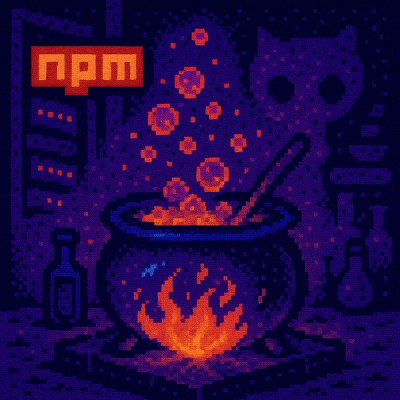
Research
/Security News
9 Malicious NuGet Packages Deliver Time-Delayed Destructive Payloads
Socket researchers discovered nine malicious NuGet packages that use time-delayed payloads to crash applications and corrupt industrial control systems.
@spectrum-web-components/alert-dialog
Advanced tools
Web component implementation of a Spectrum design AlertDialog
<sp-alert-dialog role="alertdialog" aria-labelledby="xx-heading" aria-describedby="xx-message" role="alertdialog" aria-labelledby="" aria-describedby=""> displays important information that users need to acknowledge. When used directly, the <sp-alert-dialog role="alertdialog" aria-labelledby="xx-heading" aria-describedby="xx-message" role="alertdialog" aria-labelledby="" aria-describedby=""> element surfaces a slot based API for deep customization of the content to be included in the overlay.
yarn add @spectrum-web-components/alert-dialog
Import the side effectful registration of <sp-alert-dialog role="alertdialog" aria-labelledby="xx-heading" aria-describedby="xx-message" role="alertdialog" aria-labelledby="" aria-describedby=""> via:
import '@spectrum-web-components/alert-dialog/sp-alert-dialog.js';
When looking to leverage the AlertDialog base class as a type and/or for extension purposes, do so via:
import { AlertDialog } from '@spectrum-web-components/alert-dialog';
The alert dialog consists of several key parts:
slot="heading", that uses a few words to convey the outcome of what will happen if a user continues with an actionslot="button", that allow users to respond<sp-alert-dialog
role="alertdialog"
aria-labelledby="example-heading"
aria-describedby="example-message"
variant="confirmation"
>
<h2 id="example-heading" slot="heading">Important Notice</h2>
<p id="example-message">This action requires your confirmation.</p>
<sp-button
slot="button"
variant="secondary"
treatment="outline"
onclick="this.dispatchEvent(new Event('close', { bubbles: true, composed: true }));"
>
Cancel
</sp-button>
<sp-button
slot="button"
variant="accent"
treatment="fill"
onclick="this.dispatchEvent(new Event('close', { bubbles: true, composed: true }));"
>
Confirm
</sp-button>
</sp-alert-dialog>
Use slot="button" to render your action button(s) that allow users to respond
variant="primary") with the option to include a secondary action and/or a cancel action.variant="secondary" and treatment="outline".<sp-alert-dialog
role="alertdialog"
aria-labelledby="rate-heading"
aria-describedby="rate-message"
variant="information"
>
<h2 id="rate-heading" slot="heading">Rate this app</h2>
<p id="rate-message">
If you enjoy our app, would you mind taking a moment to rate it?
</p>
<sp-button
slot="button"
variant="secondary"
treatment="outline"
onclick="this.dispatchEvent(new Event('close', { bubbles: true, composed: true }));"
>
No, thanks
</sp-button>
<sp-button
slot="button"
variant="secondary"
treatment="outline"
onclick="this.dispatchEvent(new Event('close', { bubbles: true, composed: true }));"
>
Remind me later
</sp-button>
<sp-button
slot="button"
variant="primary"
treatment="outline"
onclick="this.dispatchEvent(new Event('close', { bubbles: true, composed: true }));"
>
Rate now
</sp-button>
</sp-alert-dialog>
The alert dialog supports confirmation, information, warning, error, and destructive variants to convey the nature and importance of the message:
Confirmation is the default variant for alert dialogs. Use a confirmation variant for asking a user to confirm a choice.
<sp-alert-dialog
role="alertdialog"
aria-labelledby="disclaimer-heading"
aria-describedby="disclaimer-message"
variant="confirmation"
>
<h2 id="disclaimer-heading" slot="heading">Disclaimer</h2>
<p id="disclaimer-message">
Smart filters are nondestructive and will preserve your original images.
</p>
<sp-button
slot="button"
variant="secondary"
treatment="outline"
onclick="this.dispatchEvent(new Event('close', { bubbles: true, composed: true }));"
>
Cancel
</sp-button>
<sp-button
slot="button"
variant="accent"
treatment="fill"
onclick="this.dispatchEvent(new Event('close', { bubbles: true, composed: true }));"
>
Enable
</sp-button>
</sp-alert-dialog>
Information alert dialogs communicate important information that a user needs to acknowledge. Before using this kind of alert dialog, make sure it’s the appropriate communication channel for the message instead of a toast or a more lightweight messaging option.
<sp-alert-dialog
role="alertdialog"
aria-labelledby="information-heading"
aria-describedby="information-message"
variant="information"
>
<h2 id="information-heading" slot="heading">Connect to wifi</h2>
<p id="information-message">
Please connect to wifi to sync your projects or go to Settings to change
your preferences.
</p>
<sp-button
slot="button"
variant="secondary"
treatment="outline"
onclick="this.dispatchEvent(new Event('close', { bubbles: true, composed: true }));"
>
Cancel
</sp-button>
<sp-button
slot="button"
variant="primary"
treatment="outline"
onclick="this.dispatchEvent(new Event('close', { bubbles: true, composed: true }));"
>
Continue
</sp-button>
</sp-alert-dialog>
Warning alert dialogs communicate important information to users in relation to an issue that needs to be acknowledged, but does not block the user from moving forward.
<sp-alert-dialog
role="alertdialog"
aria-labelledby="warning-heading"
aria-describedby="warning-message"
variant="warning"
>
<h2 id="warning-heading" slot="heading">Unverified format</h2>
<p id="warning-message">
This format has not been verified and may not be viewable for some
users. Do you want to continue publishing?
</p>
<sp-button
slot="button"
variant="secondary"
treatment="outline"
onclick="this.dispatchEvent(new Event('close', { bubbles: true, composed: true }));"
>
Cancel
</sp-button>
<sp-button
slot="button"
variant="primary"
treatment="outline"
onclick="this.dispatchEvent(new Event('close', { bubbles: true, composed: true }));"
>
Continue
</sp-button>
</sp-alert-dialog>
Error alert dialogs communicate critical information about an issue that a user needs to acknowledge.
<sp-alert-dialog
role="alertdialog"
aria-labelledby="error-heading"
aria-describedby="error-message"
variant="error"
>
<h2 id="error-heading" slot="heading">Unable to share</h2>
<p id="error-message">
An error occurred while sharing your project. Please verify the email
address and try again.
</p>
<sp-button
slot="button"
variant="primary"
treatment="outline"
onclick="this.dispatchEvent(new Event('close', { bubbles: true, composed: true }));"
>
Continue
</sp-button>
</sp-alert-dialog>
Destructive alert dialogs are for when a user needs to confirm an action that will impact their data or experience in a potentially negative way, such as deleting files or contacts.
<sp-alert-dialog
role="alertdialog"
aria-labelledby="destructive-heading"
aria-describedby="destructive-message"
variant="destructive"
>
<h2 id="destructive-heading" slot="heading">Delete 3 documents?</h2>
<p id="destructive-message">
Are you sure you want to delete the 3 selected documents?
</p>
<sp-button
slot="button"
variant="secondary"
treatment="outline"
onclick="this.dispatchEvent(new Event('close', { bubbles: true, composed: true }));"
>
Cancel
</sp-button>
<sp-button
slot="button"
variant="negative"
treatment="outline"
onclick="this.dispatchEvent(new Event('close', { bubbles: true, composed: true }));"
>
Delete
</sp-button>
</sp-alert-dialog>
An alert dialog should be placed inside a modal overlay or a dialog base:
Modal overlay<sp-button id="trigger">open modal</sp-button>
<sp-overlay trigger="trigger@click" type="modal" placement="bottom">
<sp-popover>
<sp-alert-dialog
role="alertdialog"
aria-labelledby="modal-heading"
aria-describedby="modal-message"
variant="confirmation"
>
<h2 id="modal-heading" slot="heading">Important Notice</h2>
<p id="modal-message">This action requires your confirmation.</p>
<sp-button
slot="button"
variant="secondary"
treatment="outline"
onclick="this.dispatchEvent(new Event('close', { bubbles: true, composed: true }));"
>
Cancel
</sp-button>
<sp-button
slot="button"
variant="accent"
treatment="fill"
onclick="this.dispatchEvent(new Event('close', { bubbles: true, composed: true }));"
>
Confirm
</sp-button>
</sp-alert-dialog>
</sp-popover>
</sp-overlay>
<overlay-trigger type="modal">
<sp-dialog-base underlay slot="click-content">
<sp-alert-dialog
role="alertdialog"
aria-labelledby="modal-heading"
aria-describedby="modal-message"
variant="confirmation"
>
<h2 id="modal-heading" slot="heading">Important Notice</h2>
<p id="modal-message">This action requires your confirmation.</p>
<sp-button
slot="button"
variant="secondary"
treatment="outline"
onclick="this.dispatchEvent(new Event('close', { bubbles: true, composed: true }));"
>
Cancel
</sp-button>
<sp-button
slot="button"
variant="accent"
treatment="fill"
onclick="this.dispatchEvent(new Event('close', { bubbles: true, composed: true }));"
>
Confirm
</sp-button>
</sp-alert-dialog>
</sp-dialog-base>
<sp-button slot="trigger" variant="primary">Toggle Dialog</sp-button>
</overlay-trigger>
<sp-alert-banner> Elementrole="alertdialog" on the alert dialogaria-labelledby attribute that references the title's id.aria-describedby attribute that references the content's id.<h2>) for the dialog title####Buttons
FAQs
Web component implementation of a Spectrum design AlertDialog
The npm package @spectrum-web-components/alert-dialog receives a total of 3,068 weekly downloads. As such, @spectrum-web-components/alert-dialog popularity was classified as popular.
We found that @spectrum-web-components/alert-dialog demonstrated a healthy version release cadence and project activity because the last version was released less than a year ago. It has 7 open source maintainers collaborating on the project.
Did you know?

Socket for GitHub automatically highlights issues in each pull request and monitors the health of all your open source dependencies. Discover the contents of your packages and block harmful activity before you install or update your dependencies.

Research
/Security News
Socket researchers discovered nine malicious NuGet packages that use time-delayed payloads to crash applications and corrupt industrial control systems.

Security News
Socket CTO Ahmad Nassri discusses why supply chain attacks now target developer machines and what AI means for the future of enterprise security.

Security News
Learn the essential steps every developer should take to stay secure on npm and reduce exposure to supply chain attacks.